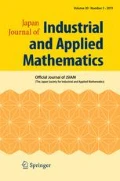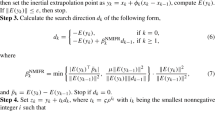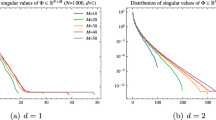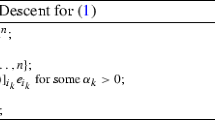Abstract
The modified Gram–Schmidt (MGS) orthogonalization is one of the most well-used algorithms for computing the thin QR factorization. MGS can be straightforwardly extended to a non-standard inner product with respect to a symmetric positive definite matrix A. For the thin QR factorization of an \(m \times n\) matrix with the non-standard inner product, a naive implementation of MGS requires 2n matrix-vector multiplications (MV) with respect to A. In this paper, we propose n-MV implementations: a high accuracy (HA) type and a high performance type, of MGS. We also provide error bounds of the HA-type implementation. Numerical experiments and analysis indicate that the proposed implementations have competitive advantages over the naive implementation in terms of both computational cost and accuracy.









Similar content being viewed by others
References
Björck, Å.: Numerical Methods for Least Squares Problems. SIAM, Philadelphia (1996)
Dubrulle, A.A.: Retooling the method of block conjugate gradients. ETNA 12, 216–233 (2001)
ELSES matrix library. http://www.elses.jp/matrix/. Accessed 15 Apr 2018
Essai, A.: Weighted FOM and GMRES for solving nonsymmetric linear systems. Numer. Algorithms 18, 277–292 (1998)
Gulliksson, M.: On the modified Gram–Schmidt algorithm for weighted and constrained linear least squares problems. BIT Numer. Math. 35, 453–468 (1995)
Higham, N.J.: Accuracy and Stability of Numerical Algorithms, 2nd edn. SIAM, Philadelphia (2002)
Imakura, A., Du, L., Tadano, H.: A weighted block GMRES method for solving linear systems with multiple right-hand sides. JSIAM Lett. 5, 65–68 (2013)
Imakura, A., Sakurai, T.: Block Krylov-type complex moment-based eigensolvers for solving generalized eigenvalue problems. Numer. Algorithm 75, 413–433 (2017)
Knyazev, A.V.: Toward the optimal preconditioned eigensolver: locally optimal block preconditioned conjugate gradient method. SIAM J. Sci. Comput. 23, 517–541 (2001)
Lowery, B.R., Langou, J.: Stability analysis of QR factorization in an oblique inner product. arXiv:1401.5171 [math.NA] (2014)
Rozložník, M., Tůma, M., Smoktunowicz, A., Kopal, J.: Numerical stability of orthogonalization methods with a non-standard inner product. BIT 52, 1035–1058 (2012)
Smoktunowicz, A., Barlow, J.L., Langou, J.: A note on the error analysis of classical Gram–Schmidt. Numer. Math. 105, 299–313 (2006)
Stewart, G.W.: Matrix Algorithms Volume II: Eigensysmtems. SIAM, Philadelphia (2001)
Trefethen, L.N.: Householder triangularization of a quasimatrix. IMA J. Numer. Anal. 30, 887–897 (2009)
Trefethen, L.N., Bau III, D.: Numerical Linear Algebra. SIAM, Philadelphia (1997)
Yamamoto, Y., Nakatsukasa, Y., Yanagisawa, Y., Fukaya, T.: Roundoff error analysis of the CholeskyQR2 algorithm in an oblique inner product. JSIAM Lett. 8, 5–8 (2016)
Yanagisawa, Y., Nakatsukasa, Y., Fukaya, T.: Cholesky-QR and Householder-QR factorizations in nonstandard inner product spaces. International Workshop on Eigenvalue Problems: Algorithms; Software and Applications, in Petascale Computing (EPASA2014) (2014)
Zhao, J.Q.: S-Orthogonal QR decomposition algorithms on multicore systems. ProQuest Dissertations Publishing, University of California, Davis (2013)
Author information
Authors and Affiliations
Corresponding author
Additional information
Publisher's Note
Springer Nature remains neutral with regard to jurisdictional claims in published maps and institutional affiliations.
The present study is supported in part by Japan Science and Technology Agency, ACT-I (no. JPMJPR16U6) and the Japanese Ministry of Education, Culture, Sports, Science and Technology, Grant-in-Aid for Scientific Research (nos. 16KT0016, 17H02828, 17K12690, 17K1996)
Appendix. Row-oriented versions
Appendix. Row-oriented versions


In Appendix, we focus on the row-oriented version of MGS (Algorithm 5) and introduce n-MV implementations: MGS-HA(row) and MGS-HP(row).
A naive implementation with 2n MV of the row-oriented MGS is shown in Algorithm 6. As is the case with the column-oriented versions (Algorithms 3, 4), we can derive n-MV implementations of the row-oriented MGS. The vector \({\varvec{p}}_i = A{\varvec{q}}_i\) is computed without MV by
as well as (4) and the vector \({\varvec{x}}_i^{(i-1)} = A{\varvec{z}}_i^{(i-1)}\) is computed without a sequential MV by
as well as (5) for MGS-HP(row). The algorithms of MGS-HA(row) and MGS-HP(row) are shown in Algorithms 7 and 8, respectively.


The proposed concept can also be applied to the row-oriented version of CGS for its n-MV implementations, CGS-HA(row) and CGS-HP(row). It is also noted that the HP-type of row-oriented versions, MGS-HP(row) and CGS-HP(row), are equivalent to the algorithms introduced in [2] to use in the block conjugate gradient method for solving linear systems with multiple right-hand sides. However, the performance of these algorithms are not analyzed and evaluated in [2], because the main objective of [2] is to propose the block conjugate gradient method.
About this article
Cite this article
Imakura, A., Yamamoto, Y. Efficient implementations of the modified Gram–Schmidt orthogonalization with a non-standard inner product. Japan J. Indust. Appl. Math. 36, 619–641 (2019). https://doi.org/10.1007/s13160-019-00356-4
Received:
Revised:
Published:
Issue Date:
DOI: https://doi.org/10.1007/s13160-019-00356-4




